
経堂駅と農大のあいだに、まだいくつかの古い家や大きい庭や成木が残っています。学生の茶色の髪と木の塀がうまく合っています。
Between Kyodo station and Nodai’s campus, a few old mansions remain with large yards and mature trees. The bicycling student’s brown hair matches the wood fence.
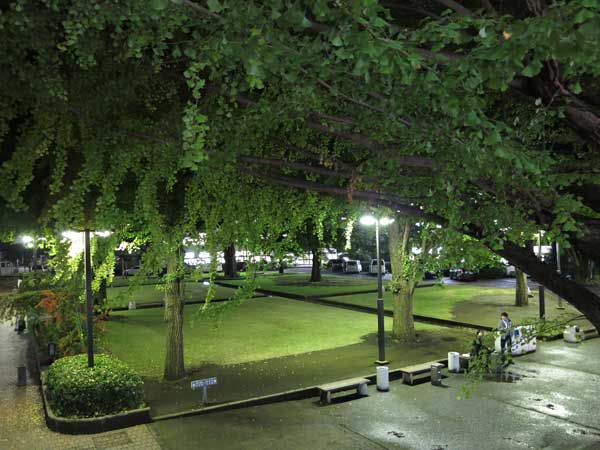
有名な多摩美のキャンパスに訪れました。夜の芝生はとてもきれいです。
Attending a guest lecture by permaculture designer Cecilia Macaulay gave me a great chance to see one campus of the famous Tamabi art school. This was taken in November so perhaps the lawn and trees no longer so lush.

This road beneath a canopy of street trees leads to the Nodai campus from Chitose Funabashi. When I commute there by bike, it makes a lovely end to my ride.

Like all of Tokyo, the Nodai campus seems to be in a state of constant demolition and reconstruction. I like how they have preserved this old grove of tall trees that remind you that this Agricultural school has a one hundred plus year history as a center of innovation and learning.
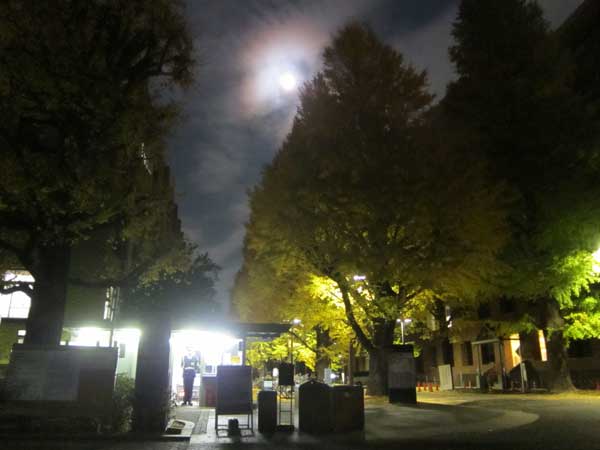
先月、東大の会議を出たとき、満月に気が付いた。
Leaving a conference last month at the University of Tokyo, I noticed the full moon above the campus.

I attended a morning lecture at the University of Tokyo about landscape planning by Harvard Graduate School of Design professor emeritus Carl Steinitz. Many wonderful examples of Chinese, European and American large-scale landscapes, and a sense of continuity with Professor Steinitz’s professor and mentor, the illustrious urban planner Kevin Lynch.
My perspective on urban planning is far removed from lofty discussions of master plans. In my mind, Tokyo is a living city despite poor planning and governance. Those who believe in planning from above have difficulty in conceptualizing or benefiting from the enormous energy and capability of ordinary residents.
Leaving the lecture and on my way to a student cafeteria curry lunch, I was thinking these thoughts when I was struck by the autumn light against the mature trees and the shadows against the early 20th century brick buildings. There was a slight stench of ginko fruit. What a prefect visual and olfactory moment.
This week I have been very fortunate to hear several lectures by architects, urban critics, and landscape designers, including events at the Norwegian Embassy and Mori Building. It’s great to recognize so many talented people focused on urban environments and living with nature. I was also fortunate to share lunch with a Hitachi executive working on Smart City Business Management, a new division involved in global city projects. It was not surprising that he is a University of Tokyo alumnus.


After watching my neighbor’s home and then garden get scarped to dirt last week, it’s great to see a cafe like this one at Waseda’s Okubo campus where the new building adapts itself to the existing mature trees. With very limited space, much longer than deep, the campus was able to add a narrow cafe that is mostly counter space with views of the sidewalk and street. I like how modern and adaptive this architecture is.

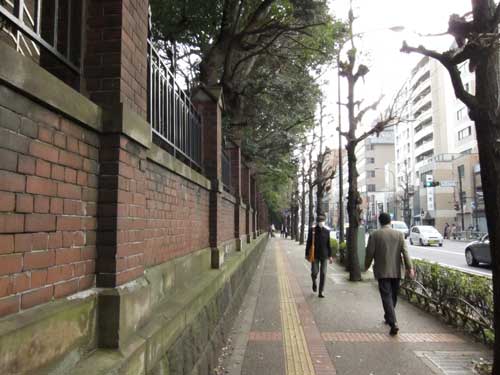
Why are the plants trapped behind the walls?
On my way to an Asian Mega-Cities urban planning conference at Tokyo University, I was struck by the streetscape outside of the famous campus. To the left is the brick-clad campus, enclosed behind a wall and covered in a mature tree canopy. The sidewalk is wide and echoes the campus with a brick in-lay and small hedge on the street side. On either side of the road are heavily pruned ginkos, still without leaves in March. Across the street from the campus are the typical urban residential and commercial buildings completely bare of leaves or green plant life in winter.
It’s wonderful that the Tokyo University campus is so well planned with mature green spaces. But I wonder why some of that plant life cannot spread across the street and out into the neighborhood.

Leaving Nodai one December day, I was struck by the bright yellow color of this ginko tree, and how it dwarfs the small street. This is the main street connecting Nodai with the Odakyu line, and the numbers of pedestrians and bicyclists far outnumber cars.
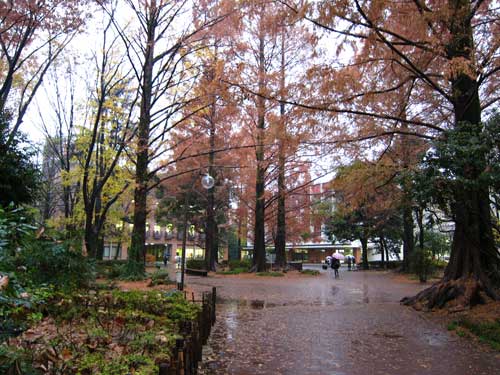
Much of Nodai’s built enviornment are 1950s Bauhaus-style six story buildings, including the one in our lab, with some newer buildings also. Outside of the library is a beautiful quad with old trees that give you a sense of the age and history of this Meiji era campus.
It was raining last Friday when I came for the Garden Lab bonenkai, or end of year party. In the middle of winter, Tokyo is very dry so I am trying to enjoy the last rain.
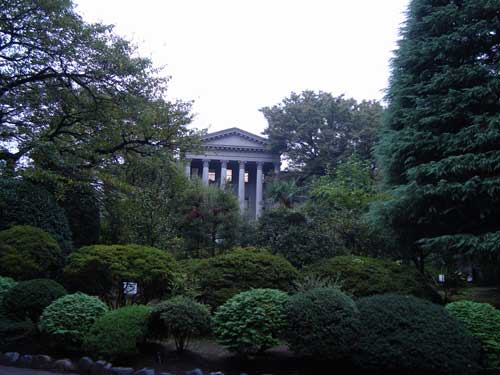
Aoyama Gakuin, one of Tokyo’s oldest schools, is a green oasis between Omotesando and Shibuya. Founded by American Methodist Episcopalians 135 years ago, the campus includes elementary to university education and has educated many of the country’s elite. The grounds include soaring trees, gardens that combine Japanese and Western styles, and neo-Gothic buildings.
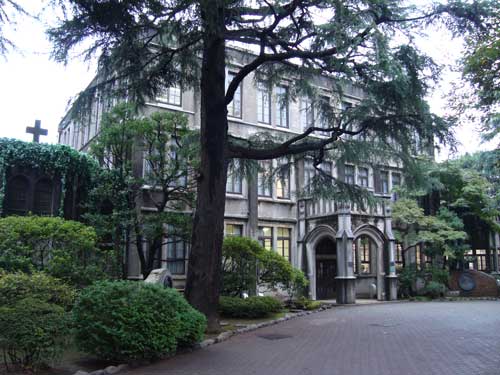
The tall pine trees reminded me of Tokyo University of Agriculture, also founded in the Meiji period, and the buildings seem intentionally Ivy League, versus the more Bauhaus buildings at Nodai. Aoyama Gakuin’s location in central Tokyo makes it a natural oasis for people and wildlife.
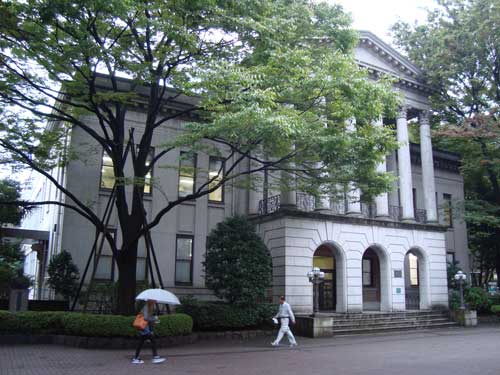

University summer break extends through the end of September. I was a bit shocked to see the Tokyo University of Agriculture laying down astro-turf on a playing field close to the center of campus. Some artificial grass defenders might say that it reduces the amount of pesticide and fertilizer, and is somehow more environmental.
Still, I wonder if paving over a huge swath of land is really more environmental. What petrochemicals have gone into the manufacturing and installation of this “ever-green” turf? It seems doubly ironic at a leading agricultural university whose plant specialists should be researching and promoting playing field turfs that stand up to heavy use and do not require chemical pesticide and fertilizer.
Given the TMG’s plans to install grass fields at primary and secondary schools, and the vast number of amateur and professional playing fields, focusing on the best natural turfs seems essential for biodiversity, storm run-off, energy independence, and heat island effect.
Update: One Nodai professor told me that with the artificial turf there will be no fireworks accompanying the famous “daikon dance” this fall. Click the Youtube video below to see this proud and somewhat strange Ag U tradition! I am looking forward to attending a “daikon dance” event this fall.
Another video featuring a strange mix of martial choreography, giant vegetables, and singer Koizumi Kyoko.